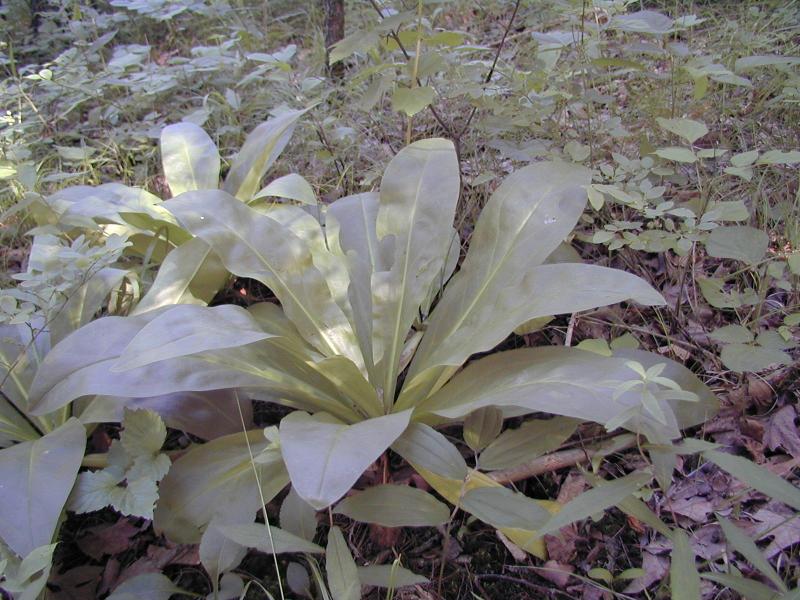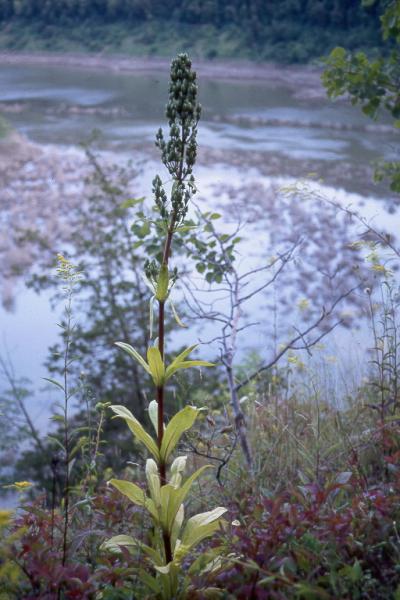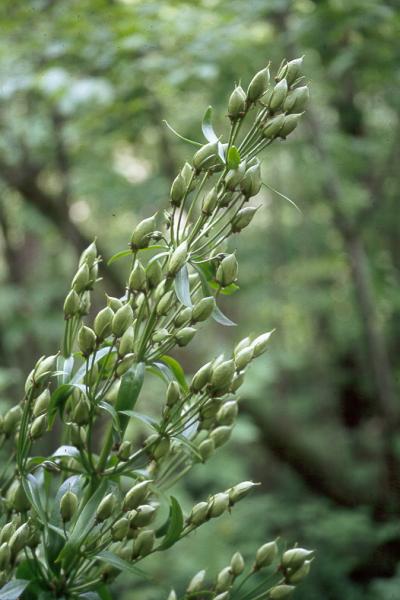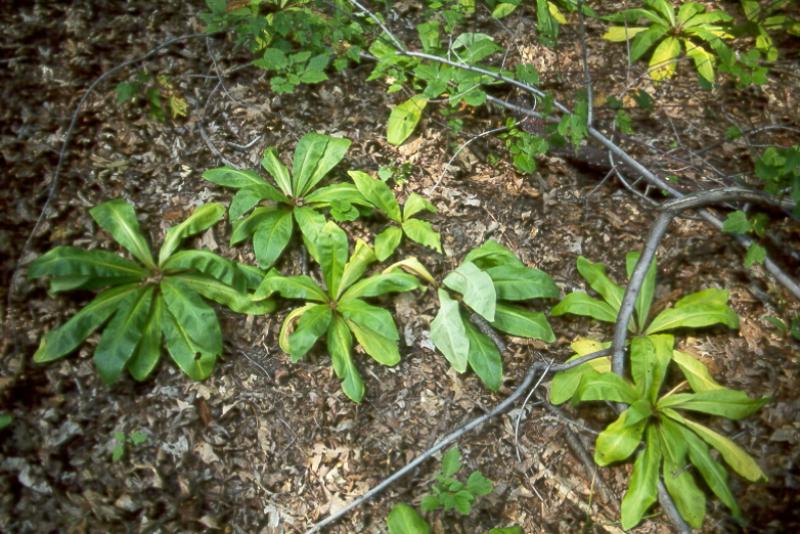Green Gentian
Frasera caroliniensis Walt.
- Class
- Dicotyledoneae (Dicots)
- Family
- Gentianaceae (Gentian Family)
- State Protection
- Threatened
Listed as Threatened by New York State: likely to become Endangered in the foreseeable future. For animals, taking, importation, transportation, or possession is prohibited, except under license or permit. For plants, removal or damage without the consent of the landowner is prohibited.
- Federal Protection
- Not Listed
- State Conservation Status Rank
- S2
Imperiled in New York - Very vulnerable to disappearing from New York due to rarity or other factors; typically 6 to 20 populations or locations in New York, very few individuals, very restricted range, few remaining acres (or miles of stream), and/or steep declines.
- Global Conservation Status Rank
- G5
Secure globally - Common in the world; widespread and abundant (but may be rare in some parts of its range).
Summary
Did you know?
The lifecycle of green gentian is known as monocarpic. It lives for up to 30 years as a cluster of basal leaves then produces one large flower stalk and dies. So this is a plant that dies shortly after its first "pollination encounter" (Committee on The Status of Endangered Wildlife In Canada 2006). It's flowering stalk is one of the largest of any wildflower species in New York. In the past, its roots were used to prepare medicines for stomach troubles (Hatfield 2004).
State Ranking Justification
Currently there are 17 populations in western New York, the majority of them in Letchworth State Park. There are only 4 historical occurrences so many more populations are not expected to be found. Presently the populations are stable but threats from logging and invasive plants may reduce their abundance.
Short-term Trends
Some populations at Letchworth State Park have been reduced in recent years but most of the populations in the state are stable at this time.
Long-term Trends
Those populations on unprotected land may be threatened by logging in the future if it is unrestricted. Invasive plant species in some of the populations may affect their future viability but the ability of Frasera to outcompete invasive plants is unknown.
Conservation and Management
Threats
Those populations on unprotected land may be threatened by logging in the future if it is unrestricted. Invasive plant species in some of the populations may affect their future viability but the ability of Frasera to outcompete invasive plants is unknown.
Conservation Strategies and Management Practices
The surrounding forest must be protected and logging must be restricted to prevent the introduction of exotic species. Any exotic invasive plants should be eliminated in the area where Frasera grows.
Research Needs
Research could be done to investigate the ability of Frasera to outcompete invasive plants.
Habitat
Habitat
This plant prefers forested slopes, bluffs, and ridges on calcareous soils that are often a dry, clay-loam or shale (NY Natural Heritage Program 2006). Open deciduous woods on calcareous soils (Rhoads and Block 2000). Dry (oak, hickory, sassafras) or sometimes moist woods and openings (Voss 1996). Rich woods (Gleason and Cronquist 1991). Dryish meadows, rich woods, and calcareous slopes (Fernald 1970).
Associated Ecological Communities
- Appalachian oak-hickory forest
(guide)
A hardwood forest that occurs on well-drained sites, usually on ridgetops, upper slopes, or south- and west-facing slopes. The soils are usually loams or sandy loams. This is a broadly defined forest community with several regional and edaphic variants. The dominant trees include red oak, white oak, and/or black oak. Mixed with the oaks, usually at lower densities, are pignut, shagbark, and/or sweet pignut hickory.
- Appalachian oak-pine forest
(guide)
A mixed forest that occurs on sandy soils, sandy ravines in pine barrens, or on slopes with rocky soils that are well-drained. The canopy is dominated by a mixture of oaks and pines.
- Beech-maple mesic forest*
(guide)
A hardwood forest with sugar maple and American beech codominant. This is a broadly defined community type with several variants. These forests occur on moist, well-drained, usually acid soils. Common associates are yellow birch, white ash, hop hornbeam, and red maple.
- Maple-basswood rich mesic forest
(guide)
A species rich hardwood forest that typically occurs on well-drained, moist soils of circumneutral pH. Rich herbs are predominant in the ground layer and are usually correlated with calcareous bedrock, although bedrock does not have to be exposed. The dominant trees are sugar maple, basswood, and white ash.
- Successional shrubland
A shrubland that occurs on sites that have been cleared (for farming, logging, development, etc.) or otherwise disturbed. This community has at least 50% cover of shrubs.
* probable association but not confirmed.
Associated Species
- Acer rubrum var. rubrum (common red maple)
- Acer saccharum (sugar maple)
- Ageratina altissima
- Agrimonia rostellata (woodland agrimony)
- Alliaria petiolata (garlic mustard)
- Amelanchier arborea (downy shadbush)
- Amphicarpaea bracteata (hog peanut)
- Antennaria plantaginifolia (plantain-leaved pussy-toes)
- Apocynum cannabinum (Indian-hemp)
- Asclepias quadrifolia (four-leaved milkweed)
- Aureolaria virginica (downy false fox-glove)
- Brachyelytrum erectum (southern shorthusk)
- Carex blanda (eastern woodland sedge)
- Carex laxiflora (loose-flowered sedge)
- Carex pensylvanica (Pennsylvania sedge)
- Carex platyphylla (broad-leaved sedge)
- Carex willdenowii (Willdenow's sedge)
- Carpinus caroliniana ssp. Virginiana
- Carya glabra (pignut hickory)
- Carya ovata
- Ceanothus americanus (New Jersey-tea)
- Comandra umbellata ssp. Umbellata
- Desmodium glutinosum
- Elymus hystrix var. hystrix (bottle-brush grass)
- Eurybia divaricata (white wood-aster)
- Eurybia macrophylla (large-leaved-aster)
- Festuca subverticillata (nodding fescue)
- Fraxinus americana (white ash)
- Galium circaezans var. circaezans
- Galium triflorum (sweet-scented bed-straw)
- Geranium maculatum (wild geranium)
- Hepatica nobilis var. acuta
- Lathyrus ochroleucus (pale vetchling)
- Lonicera morrowii (Morrow's honeysuckle)
- Maianthemum racemosum ssp. Racemosum
- Ostrya virginiana (hop hornbeam, ironwood)
- Phryma leptostachya (lopseed)
- Pinus strobus (white pine)
- Poa compressa (flat-stemmed blue grass, Canada blue grass)
- Podophyllum peltatum (may-apple)
- Polygala senega (Seneca snakeroot)
- Quercus alba (white oak)
- Quercus rubra (northern red oak)
- Sanguinaria canadensis (bloodroot)
- Shepherdia canadensis (Canada buffalo-berry)
- Solidago bicolor (silver-rod)
- Solidago caesia
- Solidago juncea (early goldenrod)
- Symphyotrichum laeve var. laeve (smooth-aster)
- Thalictrum thalictroides (rue-anemone)
- Tilia americana var. americana (American basswood)
- Toxicodendron radicans ssp. Radicans
- Viburnum acerifolium (maple-leaved viburnum)
Range
New York State Distribution
This plant is limited to western New York, particularly on bluffs and ridges adjacent to large streams. There is some speculation the Native Americans brought this plant into New York from places further west. At this point though, there is little information to support this speculative hypothesis.
Global Distribution
This plant ranges from Michigan, southern Ontario, and western New York southward to South Carolina and northern Georgia, and westward Illinois, Missouri, eastern Oklahoma, and Louisiana.
Identification Comments
General Description
Green gentian is a monocarpic perennial plant that may live as basal leaves up to 30 years or more. The large basal leaves can grow up to 1 1/2 feet and are lance-shaped and wider towards the tip. The stem leaves are in whorls of four and are progressively smaller towards the top. The flowering stem can grow from 3-6 feet tall and is topped by a large inflorescence with many branches containing 50-100 flowers and fruits. The showy flowers have four greenish-yellow petals that are purple-dotted and about 1/2 to 3/4" long. Below the middle on each petal is a large elliptic gland surrounded by a long fringe. The large fruits, almost an inch long, are elliptic and flattened.
Identifying Characteristics
A long-lived perennial plant that flowers one time and then dies. For most of its life, it only produces a basal rosette of oblong leaves that are up to a half-meter long. The leaves somewhat resemble tobacoo leaves lying flat on the ground. The flowering stalk may stand 2 meters tall with dried stalks persisting for a few seasons. The flowers appear in a loose pyramidal panicle. These are 2-3 cm broad, greenish-yellow, and marked with small brown to purple dots. The fruits are flat, elliptical, and 1.5-2 cm long.
Best Life Stage for Proper Identification
This plant may be identified vegetatively and can easily be confirmed with a digital photo. This is one our our easiest rare plants to identify vegetatively.
Similar Species
This is a very unique looking plant that should not be confused with anything in our flora.
Best Time to See
As a plant that only flowers once in its lifetime, seeing flowering plants can be difficult. Entire populations are often only present as vegetative plants. Fortunately, this plant can be identified easily from the vegetative basal rosettes. As such, surveys may be conducted at any point during the growing season. Successful surveys are even possible during the non-growing season if someone is familar with the tall flowering stalks and if the population recently flowered. When this plant flowers, flowers are typically present from early June to mid-July.
- Vegetative
- Flowering
- Fruiting
The time of year you would expect to find Green Gentian vegetative, flowering, and fruiting in New York.
Green Gentian Images
Taxonomy
Green Gentian
Frasera caroliniensis Walt.
- Kingdom Plantae
- Phylum Anthophyta
- Class Dicotyledoneae
(Dicots)
- Order Gentianales
- Family Gentianaceae (Gentian Family)
- Order Gentianales
- Class Dicotyledoneae
(Dicots)
- Phylum Anthophyta
Additional Common Names
- American Columbo
- Columbo
Synonyms
- Swertia caroliniensis (Walt.) Kuntze
Additional Resources
Best Identification Reference
Gleason, Henry A. and A. Cronquist. 1991. Manual of Vascular Plants of Northeastern United States and Adjacent Canada. The New York Botanical Garden, Bronx, New York. 910 pp.
Other References
Card, H.H. 1931. A revision of the genus Frasera. Annals of the Missouri Botanical Garden 18:245-282.
Fernald, M.L. 1950. Gray's manual of botany. 8th edition. D. Van Nostrand, New York. 1632 pp.
Holmgren, Noel. 1998. The Illustrated Companion to Gleason and Cronquist's Manual. Illustrations of the Vascular Plants of Northeastern United States and Adjacent Canada. The New York Botanical Garden, Bronx, New York.
Horn, Charles N. 1997. An ecological study of Frasera caroliniensis in South Carolina. Castanea 62 (3): 185-193.
Mitchell, Richard S. and Gordon C. Tucker. 1997. Revised Checklist of New York State Plants. Contributions to a Flora of New York State. Checklist IV. Bulletin No. 490. New York State Museum. Albany, NY. 400 pp.
New York Natural Heritage Program. 2010. Biotics database. New York Natural Heritage Program. New York State Department of Environmental Conservation. Albany, NY.
New York Natural Heritage Program. 2024. New York Natural Heritage Program Databases. Albany, NY.
Rhoads, Ann F. and Timothy A. Block. 2000. The Plants of Pennsylvania, an Illustrated Manual. University of Pennsylvania Press, Philadelphia, PA.
Threadgil, P.F. and Baskin, J.M. 1978. Swertia caroliniensis or Frasera caroliniensis. Castanea 43:20-22.
Threadgil, P.F., Baskin, J.M. and Baskin, C.C. 1981. The ecological life cycle of Frasera caroliniensis, a long-lived monocarpic perennial. The American Midland Naturalist 105:277-289.
Threadgill, P. F., Jerry M. Baskin and Carol C. Baskin. 1979. Geographical ecology of Frasera caroliniensis. Castanea 106(3): 185-188.
Voss, Edward G. 1996. Michigan Flora Part III. Dicots Concluded (Pyrolaceae - Compositae). Cranbrook Institute of Science Bulletin 61 and University of Michigan Herbarium. 622 pp.
Weldy, T. and D. Werier. 2010. New York flora atlas. [S.M. Landry, K.N. Campbell, and L.D. Mabe (original application development), Florida Center for Community Design and Research http://www.fccdr.usf.edu/. University of South Florida http://www.usf.edu/]. New York Flora Association http://newyork.plantatlas.usf.edu/, Albany, New York
Weldy, Troy W. and David Werier. 2005. New York Flora Atlas. [S.M. Landry, K.N. Campbell, and L.D. Mabe (original application development), Florida Center for Community Design and Research. University of South Florida]. New York Flora Association, Albany, NY. Available on the web at (http://newyork.plantatlas.usf.edu/).
Wood, C.E. Jr. and R.E. Weaver Jr. 1982. The genera of Gentianaceae in the southwestern United States. Journal of the Arnold Arboretum 63:441-487.
Links
- Committee on The Status of Endangered Wildlife In Canada. 2006. COSEWIC status report on the American columbo Frasera caroliniensis in Canada.
- Google Images
- Hatfield, Gabrielle. 2004. Encyclopedia of Folk Medicine. ABC-CLIO, Inc. Santa Barbara, Ca.
- NatureServer Explorer
- New York Flora Atlas
- USDA Plants Database
About This Guide
Information for this guide was last updated on: April 17, 2006
Please cite this page as:
New York Natural Heritage Program. 2024.
Online Conservation Guide for
Frasera caroliniensis.
Available from: https://guides.nynhp.org/green-gentian/.
Accessed July 26, 2024.



